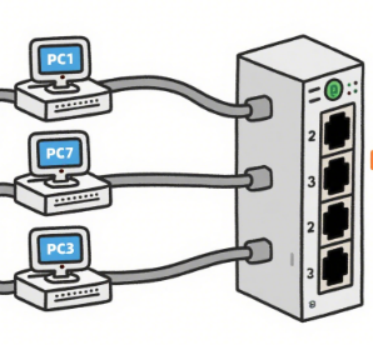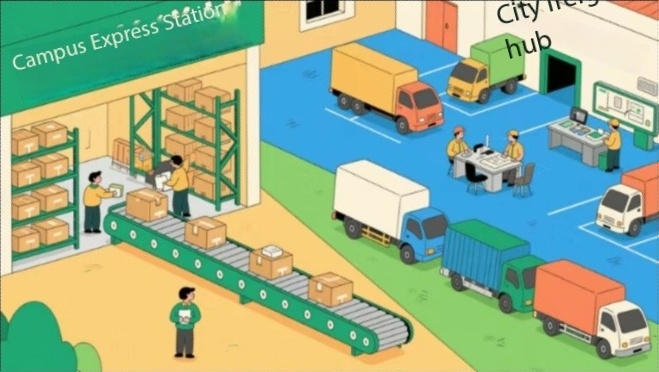Why can't a three-tier switch completely replace a router? Tell the difference at once
Good evening! My friends, Worked as a web worker You've certainly heard of three-layer switches and routers.
Many newcomers are having trouble getting started: both can be handled IP Data packets can also forward data according to the routing rules, and at first glance it looks like a carved from a mold. Is it really no difference?
But if it really doesn't make a difference, why are they still here? It's always been there. ? To put it bluntly, they are in terms of functional positioning, applicable scenarios, and technical principles, They are all different. !Today, let's start from the underlying logic of the switch, and talk about the second layer switch , the third layer switch and the router difference one-off say Well, that's clear!
For more information, please scan the WhatsApp QR code below to contact customer service.

01 Fundamentals of a switch
Whether it is a layer 2 or layer 3 switch, the core skill is data forwarding, and they are according to MAC Address Table Posted by When the switch receives a data frame, it follows this process:

1. Primary address : Extract the source from the data frame first MAC address , map it to the receiving port into the MAC table ( equivalent to " tagging " the device ) ;
2. Address of the place of inquiry : Look at the purpose of the data frame again MAC address, if there is a corresponding port in the MAC table, forwarding directly from the port;
3. Flood flooding mechanism : If If the MAC table does not record the destination address , the data frame is " advertised " - sent to all ports ( except the receiving port ) , and its MAC address and port are recorded after the target device responds ;
4. Special handling : When a broadcast frame ( sent to all devices ) or multicast frame ( sent to a specific group of devices ) , it is forwarded directly to all ports .
Let 's take an example : suppose PC1 wants to send data to PC7, the exchange machine checks the MAC table and finds that PC7 is connected to the E0 / 24 port, which is directly and accurately delivered; If the first communication, the MAC table does not have PC7 information, the first group, such as PC7 reply, the next time you can directly forward.
02 Two layer switches
The second layer switch works in OSI model of the data link layer , the core is based on MAC address Make a retweet decision.
Its working logic is clear:
1. Take the bag and take it away : Receive a packet from a port, read the source first MAC address, remember which port the device is connected to;
2. Table forwarded : Purpose of rereading MAC address, check the MAC table to find the corresponding port - there is a direct forwarding, no broadcast to all ports to ask the address;
3. High speed forwarding : Most second-layer switches have dedicated components. ASIC chip, fast forwarding speed, suitable for high-frequency data exchange in local network.
But it has a fatality. defect :Cross-network segments are Be finished ! For example! A in the 192.168.1.0 network segment, B in the 192.168.2.0 network segment, the second layer of the exchange does not know how to forward across the network segment, this time you have to ask the third layer of equipment.

03 Three-layer switches
A three-tier switch is more than a two-tier switch. Skill Support IP routing It can also be pressed within a local area network MAC address forwarding ( Layer 2 function ) , and can be routed by IP address across network segments ( Layer 3 function ) .
when A wants to send data to B of different network segments, and when communicating for the first time:
1. Check the route first. : A finds that B is not in the same network segment , sends the packet to the default gateway ( the routing module of the three-layer switch ) ;
2. Routing calculation : The three-tier switch looked at the routing table and determined to The path of B , generate a " MAC address + IP address " mapping cache ( such as B 's IP and the corresponding port ) ;
3. Follow-up directly : after A sends data to B directly through layer 2 switching , no need to check the routing table ( " once routed , many times exchanged " ) , the speed is as fast as layer 2 switch .
The exclusive advantages of a three-tier switch:
Hardware acceleration : The routing module is directly integrated into the high-speed backplane , and the forwarding rate can reach dozens Gbit / s, far beyond the traditional wayfarer;
Lightweight routing : The routing function is optimized for local area networks , simpler and more efficient than routers , suitable for a large number of cross-network segments but not complex logic ( such as internal departments of enterprises VLAN ( Virtual Local Area Network ) .
04 router
Routers also work in three layers ( network layer ) , but compared to three-layer switches , they are completely specialized It's good at it Long-distance communication across network types , such as connecting a local area network to a wide area network ( such as a home broadband router connected to the carrier network ) , networks with different protocols ( such as Ethernet and WiFi) 。
Three-layer switches What is the difference?
Contrast dimensions
| Three-layer switches
| router
|
Core function
| Mainly a layer two exchange, supplemented by a layer three routing ( "Side business")
| Dedicated three-tier routing with partial switching capabilities ( "Main business")
|
Applicable scenarios
| Inter-visits within a local area network across network segments (e.g., enterprises) VLAN interconnection)
| Interconnect across network types (e.g. LAN → WAN, different protocols)
|
Interface Type
| Single (mainly Ethernet interface)
| Rich (Support for serial ports, fiber optics, Various types of WiFi
|
Routing complexity
| Simple (just maintain the routing table within the LAN)
| Complex (Support for dynamic routing protocols, policy routing, etc.)
|
Tweet Performance
| Hardware acceleration and forward speeds are extremely fast ( ASIC chip)
| Software is mainly forwarded, and speed is limited by processor performance
|
Price Cost
| Medium to Low (Suitable for large-scale local area network deployments)
| Higher (suitable for complex network environments)
|
Take a life scenario for a second:
The three-layer switch is like the express station in the community: it can be in the community (LAN) in different buildings ( VLAN ) between quick delivery , occasionally help you transfer the package to the next block ( adjacent network segments ) ;
Routers are like cities. express delivery Company : able to move packages from one city ( network type ) to another city , supporting all kinds of trucks ( interface ) and routes ( routing protocol ) , but the delivery efficiency is not as good as the express station .
05 How do I choose? Look at the scene!
Cross-cutting within an enterprise local area network VLAN Mutual Visits : Choose a three-layer switch , which is cost-effective and fast forwarding ;
Connect to the public network / Different network types : It is necessary to use a router , such as home broadband , enterprise network to the Internet ;
Large complex networks : Three-layer switch The "internal network backbone," routers act as "export gateways," and each performs its functions.
Final focus: Three-layer switches and routers, not who replaces who relationship, but the division of labor partner。Understanding their core differences allows you to make fewer detours when networking!Don't forget to claim benefits, "The An Introduction to Net Worker Study Guide > Teach you from scratch
For more Switch and Router resources, follow the Facebook account&youtube account: Thinkmo Dumps


